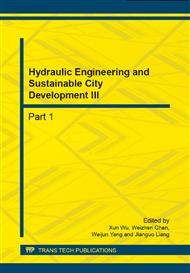p.33
p.37
p.43
p.49
p.53
p.58
p.65
p.70
p.75
Fuzzy Comprehensive Evaluation of Carrying Capacity of Water Resources in Shanxi Province
Abstract:
Based on adequate consideration of status of water resources utilization and socio-economic development in the Shanxi Provinces, the AHP method was used to calculate the weights of each index and the fuzzy comprehensive evaluation of water resource carrying capacity in the Shanxi Province was carried out from 2006 to 2011. The evaluation results indicated that the overall level of the water resources carrying capacity in Shanxi Province was contained in critical state, however, a steady rise.
Info:
Periodical:
Pages:
53-57
Citation:
Online since:
September 2014
Authors:
Price:
Сopyright:
© 2014 Trans Tech Publications Ltd. All Rights Reserved
Share:
Citation:


